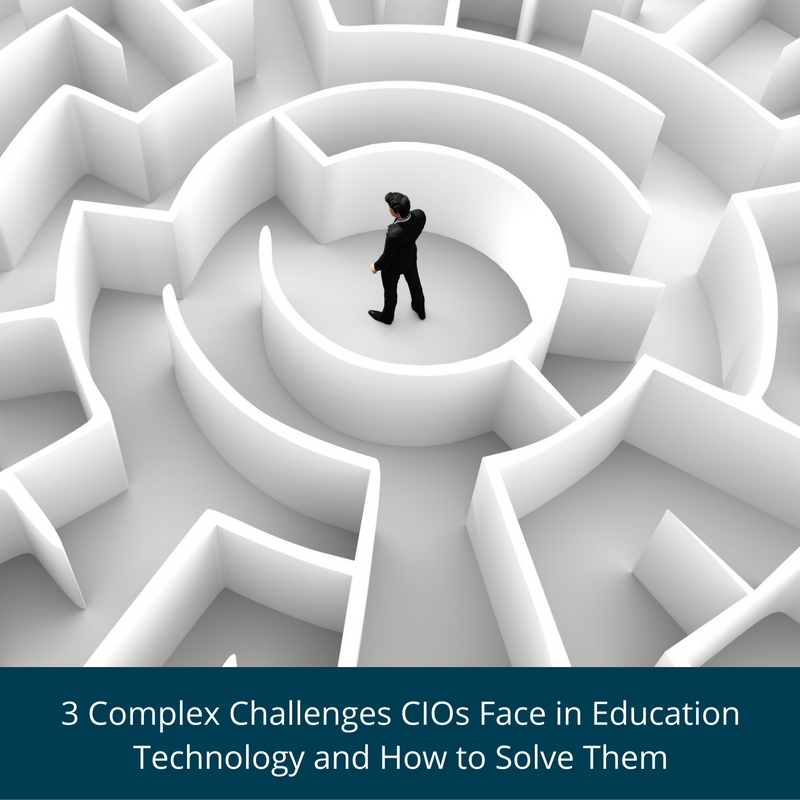3 Complex Challenges CIOs Face in Education Technology and How to Solve Them

Chief Information Officers (CIOs) face complex challenges across all industries and organizations of any size. When leading technology endeavors at education organizations, CIOs face a unique set of challenges. Education technology leaders face a variety of pressures from political, legislative, regulatory, economic, social, and technological sources. Additionally, they have the challenge of leading technological change while simultaneously acting as an IT administrator. They find themselves at a crossroads of whether to modernize or hire experts to serve on staff that specialize in legacy systems, neither of which are affordable for limited education budgets.
Below we explain three of these complex education technology challenges and proposed solutions to help CIOs get back to focusing on leadership and change.
1. Aging Infrastructure
Confronting the challenge of aging systems within the education industry is compounded by having siloed architectures, minimal budget dollars allocated for patches, fixes, upgrades, and refreshes, as well as limited budgets for best of breed technologies with superior performance. A siloed IT infrastructure is one that is segmented by domains, e.g. servers, storage, networking, etc. Siloed architectures slow production and communication because segments are not working interdependently. Knowledge is also limited because personnel specialize in just one domain. Having a siloed architecture essentially keeps an organization’s IT unprepared for modernization, not to mention the minimal budget for newer technology.
One recommended solution to dealing with aging systems is to sell legacy equipment to resellers. Buyback programs will not only help CIOs get outdated systems off their hands, but also allow budgets to stretch through awarded store credit from the purchased systems. Additionally, CIOs should consider purchasing refurbished equipment to help stretch budget dollars. Procuring a system that is one or two generations old which is warranted and has been thoroughly tested by a value-added reseller (VAR), is a win-win. The newer equipment will run more recent operating systems and applications which will in turn increase performance and productivity without breaking the bank. Lastly, it is highly recommended to secure an IT partner that specializes in all generations of hardware so they can appropriately guide education CIOs and IT teams throughout the lifecycle of equipment.
2. Staff Limitations
Staff limitations create additional challenges for education technology leaders. Staff cuts or limited resources are all too common for IT departments with limited budgets, but a unique challenge for education CIOs is the need to have personnel with working knowledge of older systems. Legacy hardware requires a special level of technical expertise which often comes with substantial industry experience and higher salary requirements.
The best solution to fill resource and knowledge gaps is to partner with an affordable and trustworthy IT vendor, particularly one with an expertise in legacy systems in this case. Surprisingly, paying an hourly or project-based fee for an affordable IT vendor is less expensive in most cases than the fees associated with recruitment, new hire supplies, benefits, and high salaries to acquire qualified candidates for in-house positions.
3. CIO Time Prioritization
The final challenge on the forefront of CIOs’ minds is being forced to split their time between fixing issues and thinking strategically. Education technology CIOs essentially must serve as part-time IT administrator and part-time IT leader to keep systems running as smoothly as possible.
In order to have more time to serve as strategic leaders, CIOs should leverage an IT partner with a keen understanding of IT solutions that will give them more time to strategize. Technology solutions that could free up IT leadership time include hybrid cloud options, or models built around Infrastructure as a Service (IaaS), Platform as a Service (PaaS), and Software as a Service (SaaS).
Limited resources, staff expertise, time, and budget dollars to allocate to IT modernization are challenges faced all too often by CIOs within the education industry. Finding a trustworthy and affordable IT partner with a buyback program, equipment expertise that spans legacy as well as new generations, and thorough understanding of service options to help IT leadership optimize their time is crucial to solving these issues for education organizations.
Subscribe to Our Content
Stay updated with Aventis Systems' latest blogs, infographics and eBooks to get the IT industry's best content!